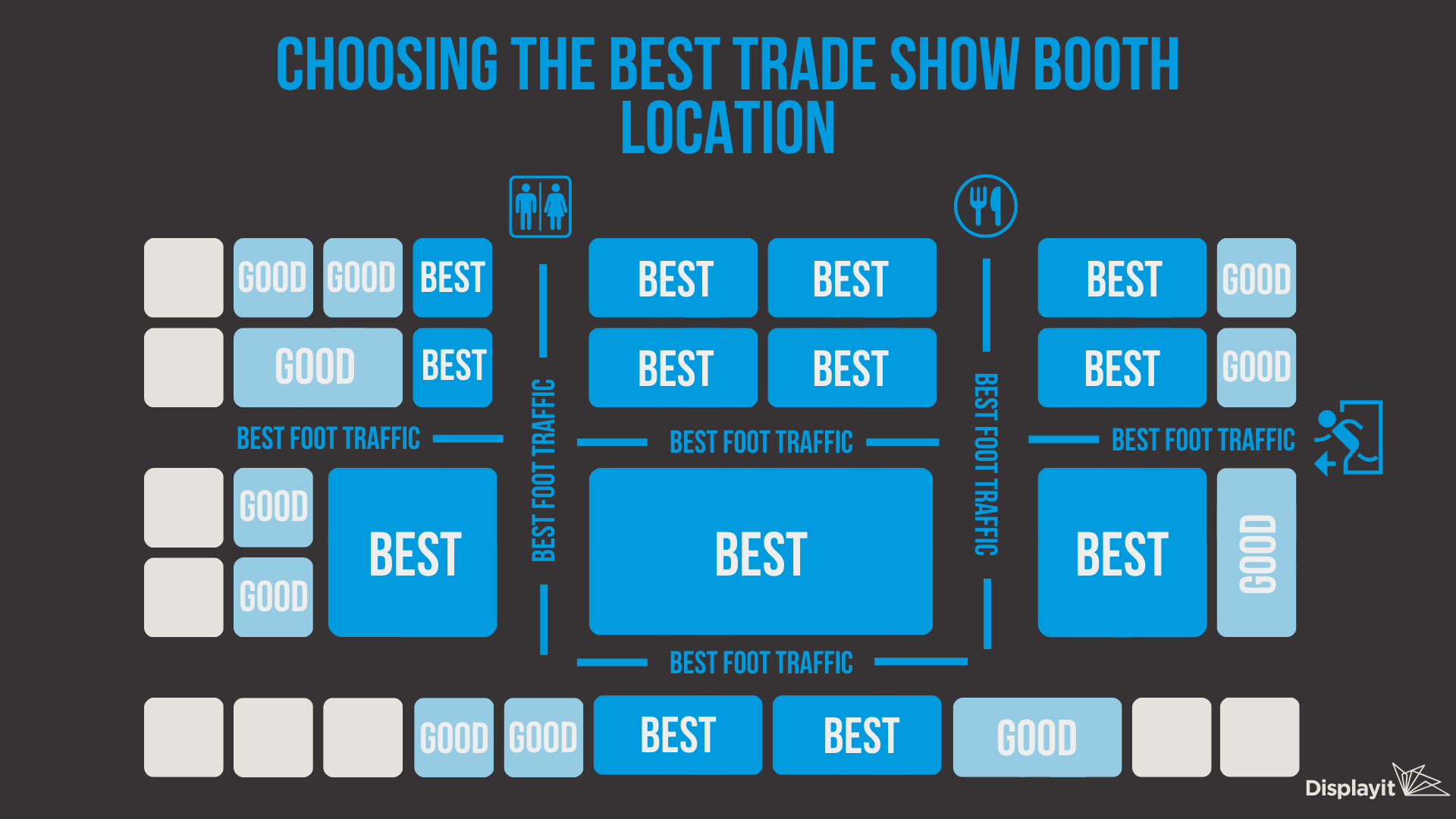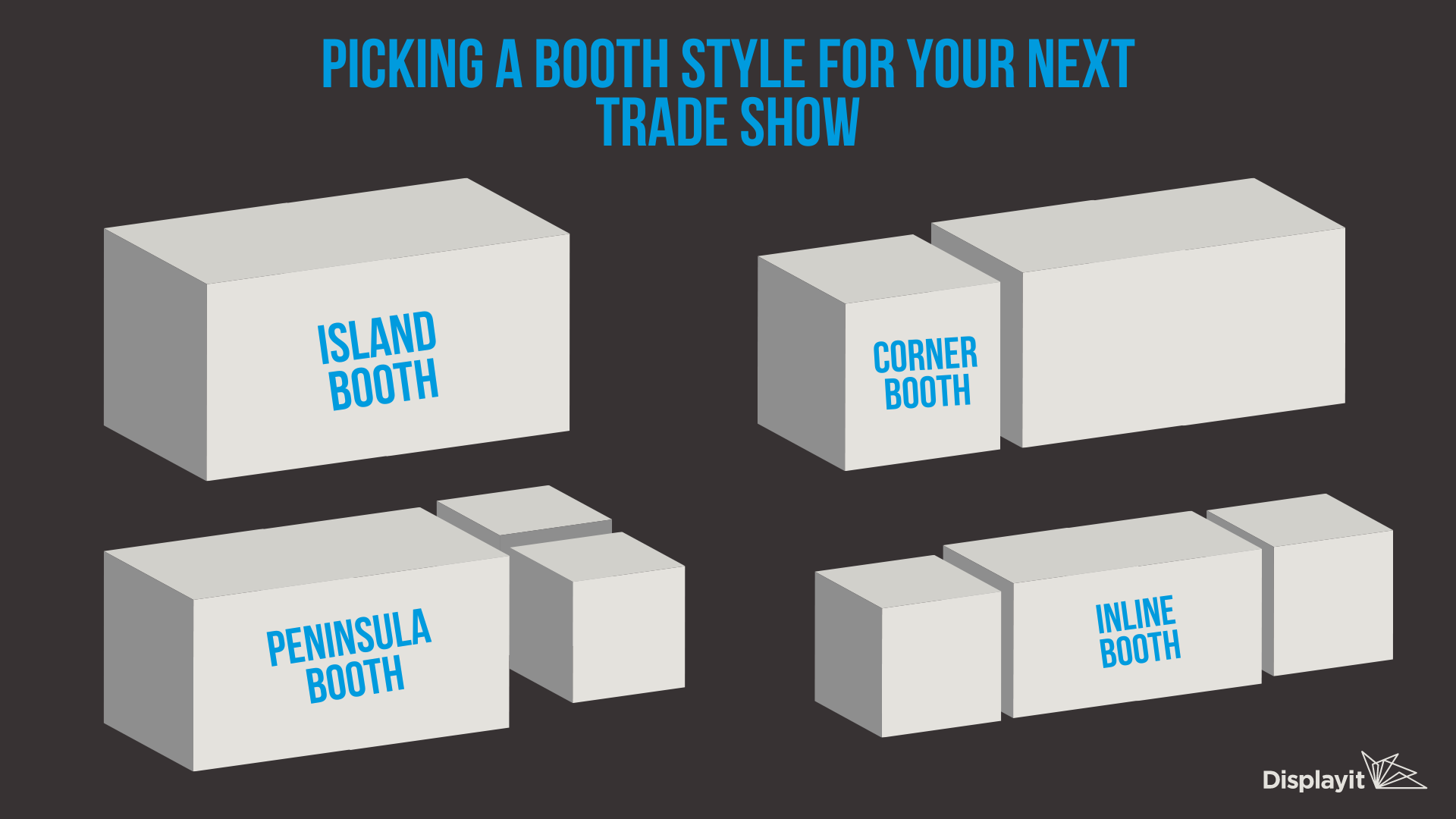Picking the right spot to reserve for your trade show booth isn’t as simple as you might think—while the dream for many businesses would be to take up the biggest, most central booth space, that’s not always possible. So when you’re selecting a spot for your booth, how do you decide which one’s best?
Ultimately, there are tons of factors that go into selecting your trade show space (many of which just come down to company preference), but there are a few key ways in which some booths will always be better than others. To help you make your choice, we’re going to walk you through the three main things to consider as you select your booth location:
- Location
- Size
- Style
Location, Location, Location
First, let’s take a look at the trade show industry’s version of that real estate adage: location, location, location. Though you’re only renting a booth space at a trade show, rather than investing in real estate, your location is still hugely important.
You’re not quite ‘investing in a neighborhood,’ but you’ve still got to keep an eye out for nearby traffic, proximity to amenities, and how you might compare to your ‘neighbors’ in the next booth spot over. Here’s how it all breaks down:
Prioritize Intersections
When it comes to getting the most traffic from conference visitors, you should always prioritize intersections. This is because anyone trying to get from one place to another (the south end of the hall to the east end of the event space, for instance) is going to have to make a turn at some point, and the grid-based layout of a trade show will naturally guide them to an intersection, while it won’t always guide them to all the various ‘halls’ between intersections.
So if you’re on an intersection, you’re way more likely to get traffic from people going to and from other locations. Beyond that, you’re also way more likely to be seen, which can really help out if you’re displaying without bright lighting.
We’ll get more into this later on, but trade show booths at intersections will generally have fewer direct neighbors than other booth locations. With fewer sides of your booth covered up by your neighboring booths, your visitors will have more angles to see you through!
Adjacent Over At
It may seem like a great idea to have a booth right next to an amenity like a food vendor, a bathroom, or an entrance—in some cases, this is true, but it all comes down to how much space you have as a ‘buffer’.
Imagine you’re a visitor at a trade show. You’ve just come out of the bathroom only to come face-to-face with a booth offering a hands-on demonstration of a product, plus the scores of people heading to use the bathroom you just came out of.
If you’re in that position, you’re probably going to want to take a second to gain your bearings and get out of the crowd (and maybe let your hands dry) before jumping right into another booth experience. For this reason, booths that are slightly offset from popular amenities might actually get the most benefit from being nearby.
Still, it’s not a bad idea to prioritize being closer to an amenity if you’re trying to decide between that and a booth at the most isolated, least trafficked area of the event space.
Competitors & Hallmark Booths
Lastly, consider your neighbors. If you believe your product and booth will outshine a competitor’s, it’s not a terrible idea to set up shop near theirs—that way, visitors will always have the opportunity to compare before deciding between one service provider or another (and if your product or service is superior, that opportunity should be a good thing!).
Proximity to similar (but not necessarily competitive) businesses also increases your chances of being found by ‘accident’—visitors looking for roofing services at a small business trade show, for instance, might also be on the market for gutter cleaning and landscaping services, so popping up shop near a roofing booth isn’t a bad choice for those sorts of businesses.
Beyond that, you also might want to look into ‘hallmark’ booths at the show—booths operated by a major sponsor, by the trade show itself, or by other major brands. Visitors are most likely to seek these booths out due to their name recognition or scale alone, so putting yourself nearby might snag you a few more visitors as well.

Size Matters
In general, it’s better to have a bigger booth space (more real estate = more eyes and more room to provide great experiences for visitors!) though there are still instances where a small, more ‘personal’ booth experience is better for your brand. Whichever you think is best for you, it’s important to know the difference between the standard trade show plot sizes:
10x10 Trade Show Spaces
A 10’ x 10’ booth is the standard booth size for most trade shows and gives you plenty of space to make an impact if you’re looking for the most efficient way to make an impact (or are trying to figure out what size of kit you should invest in) a 10’ x 10’ is the best route.
It’s also worth noting, though, that not all trade shows will have a 10’ x 10’ plot size available for you, especially if you’re reserving late in the game—make sure to double-check the specifications on your booth to see if you’ll need to fill up a bit more space than just a standard 10’ x 10’ kit (such as a 10’ x 15’ or larger booth), or if you might be better off with an alternative size (like a 10’ x 8’ kit or smaller).
10x20 Trade Show Spaces
If you’re hoping to make a bit more of a splash at your next show, a 10’ x 20’ booth may be the best fit for you. A bigger booth like this has a couple of advantages—as we said before, it simply provides more space to show off more of what makes your brand special (more product demonstrations, more room for salespeople and equipment, etc.) but it provides another advantage that may not be as obvious: fewer neighbors.
The larger your booth is, the more likely you are to have fewer neighbors crowding around your booth—bigger booths are often paired with other big booths in a trade show floor plan, so you’re more likely to see two 10’ x 20’ booths together rather than a 10’ x 20’ booth surrounded by 10’ x 10’ booths, each of which provides another opportunity to distract visitors from your own product.
Similarly, the larger you go in size, the more control and presence your brand will get—30’ and larger trade show plots very rarely butt up against other plots and are most likely to be provided in the coveted ‘island’ booth style (which we’ll cover later in this article!).
Alternative Booth Sizes
If you’re struggling to find (or afford) 10’ x 10’ spaces on the trade show floor, it’s important to still keep ‘uniquely sized’ spaces in mind. 10’ x 5’ spaces, for instance, won’t fit a 10’ x 10’ booth, but can still serve as a great space when combined with banner stands, tables, counters, and a bit of creativity!
Picking a Booth Style
The last thing to keep in mind when looking at trade show spaces is the ‘style’ of the booth location itself. This isn’t referring to the type of trade show display you put in your booth space, but is more about how and where your spot is positioned.
The key here is that the more open sides your booth has (sides without a neighboring booth), the better, and each number of sides basically serves as its own ‘style’ of booth space. Here they are in order of least-exposed to most-exposed:
Inline
An inline booth space is one that’s arranged end-to-end with others. When there’s a long row of booths, and each booth has another booth on each side and behind it, it’s considered ‘inline’. With this booth style, only one side of the booth is actually exposed to visitors: the front. That means it’s not ideal in terms of getting visitor’s attention, but it's also one of the most common booth styles out there.
Corner
A corner booth is a lot like an inline booth, but instead of having adjacent booths on three sides (left, right, and rear) it only has booths on two. Corner booths are often at the end of back-to-back inline sections, and provide a little bit more visibility. You’ll often find corner booths at popular intersections, as well, so these are a great option for that reason too.
Peninsula
Peninsula booth spaces have one side that’s adjacent to another booth, while three whole sides are exposed. These booth spaces are often found in very high-traffic areas and provide tons of visibility. Notably, they are also the easiest and most effective space type to combine with a trade show display backwall.
Island
Island display spaces are the best of the best in terms of space options—with four exposed sides and locations that are often at the center of traffic, an island space is an ideal plot for any business that wants to be at the nexus of its next show and knows they can make it happen.
But they aren’t the best for every business. Island spaces are usually quite large and present a unique challenge for businesses due to their size, isolated location, and wraparound visibility—displaying in an island plot with a single-sided backwall, for instance, means that one whole side of the plot isn’t going to have anything meaningful for visitors.
Creating a unique display that takes full advantage of this sort of space isn’t easy, but it certainly can be done (especially with a show-stopping custom display).

Ready to Exhibit?
Hopefully, this article helped you narrow down which booth space might be best for you. Your next step: find a display kit to fill it!
OR



